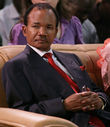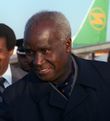Zambian general election, 1991
| |||||||||||||||||||||||||||||||
| |||||||||||||||||||||||||||||||
| |||||||||||||||||||||||||||||||
General elections were held in Zambia on 31 October 1991 to elect a President and National Assembly. They were the first multi-party elections since 1968, and saw the ruling United National Independence Party comprehensively beaten by the Movement for Multi-Party Democracy, whose candidate, Frederick Chiluba, beat the incumbent Kenneth Kaunda in the presidential election. Voter turnout was 45%.[1]
Background
Following Zambia’s independence in 1964, UNIP dominated the political landscape under Kaunda. However, by the late 1980s, economic decline, widespread public dissatisfaction, and mounting pressure for democratic reforms led to increased calls for political pluralism. In July 1990, President Kaunda agreed to constitutional amendments that would reintroduce multi-party politics.
The Rise of MMD
The Movement for Multi-Party Democracy (MMD) emerged as a coalition of trade unions, civic groups, and former UNIP members opposed to Kaunda’s authoritarianism. Led by former trade unionist Frederick Chiluba, the MMD rapidly gained popular support across the country.
Election Campaign
The 1991 elections featured two main contenders:
- Frederick Chiluba (MMD) – campaigning on a platform of economic reform, good governance, and a return to democratic rule.
- Kenneth Kaunda (UNIP) – defending his record and warning of the potential instability of regime change.
The elections were closely monitored by international observers and were considered largely free and fair, despite some logistical issues.
Results
Frederick Chiluba won a landslide victory with over 75% of the presidential vote, while the MMD secured 125 of the 150 seats in the National Assembly. Kaunda conceded defeat peacefully, marking a rare and commendable democratic transition in Africa at the time.
Presidential Results
| Candidate | Party | Votes | % |
|---|---|---|---|
| Frederick Chiluba | Movement for Multi-Party Democracy | 972,212 | 75.76 |
| Kenneth Kaunda | United National Independence Party | 311,022 | 24.24 |
| Invalid/blank votes | 41,531 | – | |
| Total | 1,324,765 | 100 | |
| Registered voters/turnout | 2,926,457 | 45.27 | |
| Source: EISA | |||
Parliamentary Results
| Party | Votes | % | Seats | +/– |
|---|---|---|---|---|
| Movement for Multi-Party Democracy | 931,945 | 74.01 | 125 | New |
| United National Independence Party | 314,711 | 24.99 | 25 | –100 |
| National Democratic Alliance | 1,695 | 0.13 | 0 | New |
| National Democratic Party | 803 | 0.06 | 0 | New |
| Democratic Party | 120 | 0.01 | 0 | New |
| Independents | 9,862 | 0.78 | 0 | New |
| Presidential appointees | – | – | 8 | –2 |
| Appointed Speaker | – | – | 1 | 0 |
| Invalid/blank votes | 46,787 | – | – | – |
| Total | 1,305,689 | 100 | 159 | +23 |
| Registered voters/turnout | 2,875,960 | 45.40 | – | – |
| Source: EISA | ||||
Aftermath
The peaceful transfer of power in 1991 was hailed globally as a democratic milestone. Frederick Chiluba’s presidency ushered in economic liberalisation policies, although his administration later faced corruption allegations. Kenneth Kaunda retired from active politics for several years before briefly returning in the mid-1990s.
Legacy
The 1991 elections are remembered as one of Zambia’s most significant political events. They demonstrated the power of peaceful civic mobilisation and set a precedent for democratic governance in the region.

